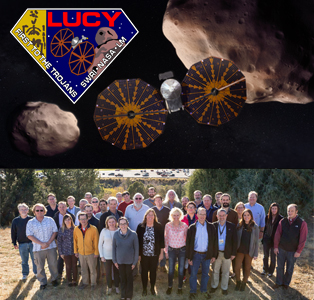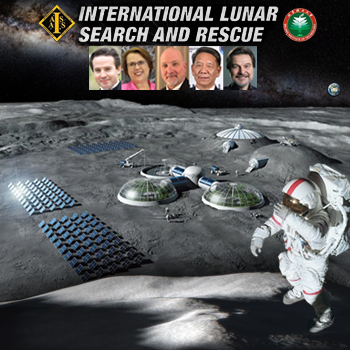Jupiter Trojan Surveyor Lucy Returns for LEO Gravity Assist, Many Additional Asteroid Missions Being Prepared
|
MONDAY☆ Oct 10 — ISS, ~415-km LEO: Expedition 68 / SpaceX Crew-5 Nicole Mann, Josh Cassada, Koichi Wakata, Anna Kikina join 7 Astronauts and Cosmomauts transferred from Expedition 67; Roscosmos Sergei Krikalev seeks extension of ISS partnership. ☆ Oct 10 — Tiangong Space Station, ~390-km LEO: Shenzhou 14 three-member crew preparing for arrival of final main station component Mengtian (Dreaming of Heavens) laboratory module, launching this month from Wenchang SLC via Long March 5B. Highlights… o NewSpace: ispace conducting mission training at Tokyo control center ahead of November lunar launch; Redwire, Bradford Space & Swedish Space Corporation to collaborate on commercial space debris mitigation; Firefly CEO touts marketability of Alpha medium-lift launch vehicle / US$15M per launch following inaugural flight. ☆ Solar System: 10,000-km plume of DART spacecraft / Dimorphos ejecta being observed by Southern Astrophysical Research Telescope on Cerro Pachón, Chile; Cambridge study of Mars Global Surveyor Laser Altimeter readings finds evidence of geothermal activity, liquid water under Mars south pole icecap. ☆ Galaxy: Study of Fermi Large Area Telescope data suggests asymmetrical “cocoon” within Fermi Bubble caused by gamma rays emitted from millisecond pulsars; 86 scientist / 37 observatory / 13 country Whole Earth Blazar Telescope collaboration study light oscillations from galactic nucleus BL Lacertae. o Global: China Manned Space Agency recruiting 10-12 Taikonauts from across China, including Macao and Hong Kong; ESA RFI seeks interest in lunar commercial communication initiative Moonlight in support of European Large Logistics Lander, Gateway, and 250 mission / $99B lunar market (by 2031) forecast by Northern Sky Research. ● USA: SpaceX, NASA studying feasibility of Hubble orbit raising maneuver utilizing Dragon as part of Polaris mission series; FCC to enforce 5-year deorbiting policy on spacecraft that end service life below 2,000 km; Planet to begin deploying hyperspectral Tanager Earth observation constellation with 30-m resolution, 400+ spectrum capability NET 2023. ● Hawai’i: 2-kg meteor from Oort cloud observed over Alberta may be example of ‘Manx Comet’ discovered by IfA Planetary Astronomer Karen Meech via PANSTARRS; Keck Telescope and Gran Telescopio Canarias being used to characterize ZTF J1813+4251, a cataclysmic variable binary system with ultrashort 51 minute orbital period. |
 |
● = Terrestrial events, and…
o = International terrestrial events in local time. ★ = Space events, and… ☆ = International space / astro events in Hawaii Standard Time unless noted. Add 10 hours to obtain UT (‘Universal Time’). |
Weekly Planet Watch – Morning Planets: Mercury (E); Evening Planets: Mars (ENE), Jupiter (SE), Saturn (S), Uranus (E), Neptune (SE).
1st International Lunar Search and Rescue Conference Set for Oct 13-15 Participation in Beijing / Online
|
☆ Oct 10 — Starlink G4-27 Satellites, LEO: Visible pass over Hawai’i Islands (magnitudes 5.7-6.0) of G4-27 batch of Starlink satellites from the South, starting 04:23:11 to 04:59:59. ☆ Oct 10 — Apollo Asteroid 2019 TA1: Near-Earth Flyby (0.092 AU) ☆ Oct 10 — Apollo Asteroid 2022 SE10: Near-Earth Flyby (0.014 AU) Continued From… ★ Jun 28 – Nov 13 — CAPSTONE, Near-Rectilinear Halo Orbit Trajectory: Cislunar Autonomous Positioning System Technology Operations and Navigation Experiment heading to operating position at NRHO / cislunar space. ☆ Aug 4 – Dec 16 — Korea Pathfinder Lunar Orbiter (KPLO), Lunar Trajectory: South Korea ‘Danuri’ to search for lunar resources, test technologies using Ballistic Lunar Transfer, 3 highly elliptical Earth orbits to initiate a trans-lunar injection and arrive at 100-km lunar orbit. o Aug 8 – Nov 11 — IAU, NAOJ, NARIT, Online / Global: NameExoWorlds 2022. o Oct 4-10 — World Space Week Association, Global: World Space Week 2022: Space and Sustainability; to celebrate international contributions of space science and technology to the betterment of the human condition; Oct 4 is 65th observation of 1st Space mission Sputnik One launched by Soviet Union 1957; Oct 10 is 55th observation of Outer Space Treaty going into effect 1967. TUESDAYo Oct 11-12 — European Space Policy Institute (ESPI), Vienna, Austria: 16th Autumn Conference: Space Economy and Commerce: The Way Ahead for Europe; at Urania Observatory. ● Oct 11-14 — SatNews, Hughes, Airbus, Firefly Aerospace, Raytheon, Redwire, et al, Mountain View CA: Silicon Valley Space Week: Satellite Innovation Conference, followed by 2022 MilSat Symposium; at Computer History Museum. ☆ Oct 11 — Moon: 0.80° N of Uranus, 21:00. |
WEDNESDAY
★ Oct 12 — SpaceX, Launch Falcon 9 / Hotbird 13F, SLC-40, Cape Canaveral SFS FL: SpaceX to launch Hotbird 13F television broadcasting satellite for Eutelsat; launch opens 23:25 EDT.
● Oct 12-13 — Beyond Earth Institute, University of Arizona Space Safety, Security and Sustainability Center (Space4 Center), Hybrid / Washington DC and Online: Beyond Earth Institute Policy Symposium; Crafting the Policies that Will Enable Humanity’s Future in Space; featuring Pete Worden (Chair), Kathy Lueders, Bhavya Lal, Johann-Dietrich Wörner, Michelle Hanlon, Scott Pace, many more.
● Oct 12-13 — Extraterrestrial Materials Analysis Group (ExMAG), NASA, Online / Washington DC: Fall Meeting of ExMAG 2022.
● Oct 12 — Space Transportation Association, Washington DC: STA Luncheon with NASA Wallops Director Dave Pierce.
☆ Oct 12 — Moon: 2.53° SE of Pleiades, 21:00.
☆ Oct 12 — Apollo Asteroid 2022 RA5: Near-Earth Flyby (0.033 AU)
THURSDAY
● Oct 13 — Women in Aerospace (WIA), Arlington VA: WIA 2022 Awards Dinner and Ceremony; begins 18:00.
o Oct 13-15 — International Association for the Advancement of Space Safety (IAASS), Beijing Institute of Technology (BIT), Hybrid / Beijing, China and Online: 1st International Lunar Search and Rescue Conference.
☆ Oct 13 — Moon: 7.8° N of Aldebaran, 14:00.
☆ Oct 13 — Apollo Asteroid 2022 SX24: Near-Earth Flyby (0.059 AU)
☆ Oct 13 — Apollo Asteroid 2022 SG6: Near-Earth Flyby (0.040 AU)
FRIDAY
● Oct 14 — National Academies of Sciences, Engineering and Medicine, Online: Space Weather Roundtable of the National Academies.
● Oct 14-21 — Imagine Science Films, NYC NY: 15th Annual Imagine Science Film Festival 2022: Science New Wave.
☆ Oct 14 — Moon: 3.6° N of Mars, 18:00.
☆ Oct 14 — Apollo Asteroid 2013 SL20: Near-Earth Flyby (0.016 AU)
☆ Oct 14 — Apollo Asteroid 2022 QF41: Near-Earth Flyby (0.069 AU)
☆ Oct 14 — Apollo Asteroid 2021 GV3: Near-Earth Flyby (0.071 AU)
SATURDAY
● Oct 15 — University of Nebraska – Lincoln, Washington DC: 15th Annual Space Law Conference: Operating in Space: Current Issues in Military and Commercial Uses of Space.
● Oct 15 — National Space Society – Sacramento L5 Chapter, Online / Sacramento CA: NSS Chapters Assembly Meeting; 07:00 PDT.
● Oct 15 — AIAA Los Angeles – Las Vegas Section, Hybrid / Lawndale CA and Online: AIAA LA-LV Section Town Hall Meeting 2022.
☆ Oct 15 — Moon: 3.1° N of M35 cluster, 11:00.
☆ Oct 15 — Apollo Asteroid 2020 TO2: Near-Earth Flyby (0.003 AU)
☆ Oct 15 — Aten Asteroid 2022 SY10: Near-Earth Flyby (0.016 AU)
☆ Oct 15 — Apollo Asteroid 2022 SK48: Near-Earth Flyby (0.045 AU)
☆ Oct 15 — Aten Asteroid 2012 TR231: Near-Earth Flyby (0.081 AU)
☆ Oct 15 — Amor Asteroid 2020 PK7: Near-Earth Flyby (0.086 AU)
SUNDAY
★ Oct 16 — Lucy, Earth Flyby / Gravity Assist, Main Asteroid Belt Trajectory: NASA mission to encounter 8 different asteroids including a main belt and 7 Jupiter Trojans to perform first Earth flyby / gravity assist today with target altitude of 300 km.
☆ Oct 16 — Apollo Asteroid 2022 SK15: Near-Earth Flyby (0.024 AU)
☆ Oct 16 — Apollo Asteroid 2020 BD: Near-Earth Flyby (0.030 AU)
☆ Oct 16 — Aten Asteroid 2022 QM6: Near-Earth Flyby (0.050 AU)
☆ Oct 16 — Apollo Asteroid 2021 TC1: Near-Earth Flyby (0.061 AU)

